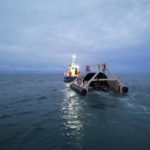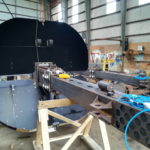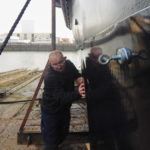When the EU biocide regulation becomes valid in 2019, it will cause an increasing demand for alternative antifouling coatings. Renolit has therefore developed a solution using biocide-free films
The most popular way of preventing fouling in the maritime industry continues to be biocide-based antifouling paints. When it[ds_preview] comes into contact with seawater, the paint releases toxic biocides which prevent marine growth. However, the negative impact of those biocides cannot be denied. The worldwide prohibition of antifouling coatings which contain tributyltin (TBT) in 2008 was a first step the IMO took towards more environmentally friendly antifouling. Today, the new EU biocide regulation, which came into force in 2013, is setting new standards.
All biocide-based products must now be approved before their introduction into the European market. However, only products whose substances have already been authorised can be approved in this two-stage process. It is assumed that this regulation, when it becomes valid in 2019, will cause a drastic decline of new products and an increasing demand for alternative antifouling coatings.
One of the most promising alternatives to conventional paints is the use of films. For several years, the experts from Renolit, a family-owned business and international leader in the manufacture of high-quality plastic films, have worked on a new product, which would solve the problem of toxic antifouling coatings. Based on the principle of fouling release, they developed a film which offers an alternative to conventional paints.
Although a lot of ship-owners are sceptical about the effectiveness of antifouling films, thorough test results have shown this scepticism to be unfounded.
The unique technique of fouling release films
The Renolit antifouling films are based on a high-quality fluoropolymer layer and are totally free of biocides. Due to their fouling release properties, marine organisms cannot entirely adhere to the ship’s hull and are washed off simply by the speed of the moving vessel (above 7 kn).
One of the unique features of the film is that it turns the ship’s hull into an amphiphilic surface. Studies have shown that there are certain types of barnacles which primarily adhere to hydrophobic surfaces and other types which adhere primarily to hydrophilic surfaces. Previous antifouling coatings based on silicone only have hydrophobic properties and would therefore only prevent the adhesion of those barnacles that settle hydrophobic surfaces. The »Renolit Dolphin S« film combines these two properties and is thereby »amphiphilic«.
Long-term laboratory tests
The Laboratory for Freshwater and Marine Research (LimnoMar) has investigated the long-term effects of the films in direct comparison with other antifouling coatings for more than three years. On a whole, 13 inspections have been carried out in which the films were checked for any traces of barnacles, shells, algae or biofouling. After completion of these inspections, the film received a rating of 97 on the so-called fouling rating scale, whereby zero means full fouling and 100 means no fouling at all.
Long-term test on a mooring boat
Furthermore, the »Renolit Dolphin S« film was applied to the hull of the mooring boat »Lütt Deern« in February 2016. In October 2017, it had to be taken out of the water for repairs. This provided the perfect opportunity to examine the special functionality of the film.
Benito di Racca, owner of the »Lütt Deern« and Managing Partner of H.S.H. Schleppgesellschaft, made the trip to the M.A. Flint shipyard for the event. »When the boat was taken out of the water, there was hardly any deposit build-up on the hull. No fouling, no shells. For me, this means that the film works«, says Benito di Racca.
As a result of the positive experience, two more films have been applied to the boat. An extremely stable protective film, which offers protection against bad weather, UV radiation and bleaching (»Renolit Shark«) was applied to the part of the ship’s hull that is above water. An anti-corrosion film (Renolit Nautilus) was applied to the wheelhouse.
Long-term test in a wave power project
»Wavepiston« is a wave power project aiming at setting new standards in the area of renewable energy. The idea of the project for winning power from waves is quite simple: A steel wire is stretched between two anchored buoys. On the wire, various energy collectors are mounted at a distance of 5to 6m. As the waves move, the plates are likewise moved back and forth, thereby pumping seawater into both a pipe and a turbine onshore. Strong swells are needed to produce the most energy, and these are mainly found in fishing areas, which is why the Wavepiston prototype is located in such an area near the Port of Hanstholm, Denmark (as of November 2017). However, Wavepiston has experienced one major problem to date: fouling. Algae or barnacles adhere to the plates, making them ineffective and heavy to move. Most of the known antifouling coatings are biocidal, and since the energy collectors of Wavepiston are located in fishing areas, the use of biocidal products is prohibited.
The Danish Society of Engineers (IDA) presented Wavepiston to Renolit, and after thorough discussions, the eight energy collectors of the 120-m-long prototype in Hanstholm now feature a Renolit antifouling film: the flock film »Renolit Seal« which not only has an antifouling effect but also increases friction and resistance. The long-term reliability and efficiency are still to be evaluated.
Six reasons for using Renolit films:
• Lower total cost of ownership: The roll-coating technology enables simple application, keeps surfaces clean, safe and protected. It lasts longer and thus contributes significantly to operational efficiency.
• Easy preparation: In general, the same surface preparation is needed as with paints. However, no time is wasted with masking the surrounding surfaces since there is no risk of overspray and no silicone contamination.
• Simple application: The films fit various shapes and can be applied at temperatures between 10 and 30°C and in high-humidity. They are easy to apply, as mixing of components is not necessary (eliminating pot life). They deliver instant functionality: one layer, no curing time.
• Time-saving: The films are easy to clean, without risk of flammability, maintenance jobs (e.g.welding) can be done in parallel. There is no drying time and repairs can be done quickly and easily using film patches.
• Better surface protection: There is good resistance to abrasion and scratches, and a double anti-corrosion barrier (adhesive and film). The films offer effective protection due to consistent thickness and quality.
• Harmless to humans and the environment: The films are biocide-free and no volatile organic compounds (VOC) are released. This enables easier Health Safety Environment (HSE) Management.


















